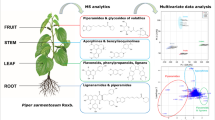Summary
The extraction of crude drugs by using different solvents provides polarity-based fractions containing specific types of secondary metabolites. Averrhoa carambola L. fruits were extracted and fractionated, and petroleum ether extract was processed by fatty acid methyl ester (FAME) technique for characterization by gas chromatography–mass spectrometry (GC–MS) analysis. The remaining part was extracted with methanol for high-performance thin-layer chromatography (HPTLC) analysis, for simultaneous quantitative determination of gallic acid, protocatechuic acid, and quercetin in methanolic fractions. Petroleum ether and methanol fractions were found to be the best for the highest possible recovery of target analytes. The chromatographic elutions of FAME compounds generated from ether extract were evaluated by GC–MS profiling. Ten fatty acid compounds were separated with the highest quantity of oleic acid methyl ester (42.88%). On other hand, polar fraction was processed by HPTLC profiling. For achieving good separation, a mobile phase of toluene–ethyl acetate–formic acid (5:4:1, v/v) was used. The densitometric determination was carried out at 310 nm in reflection–absorption mode. The calibration curves were linear in the range of 100–600 ng per spot for gallic acid, protocatechuic acid, and quercetin. During the analysis, the dried raw material from A. carambola L. fruits showed the presence of gallic acid (0.96%), protocatechuic acid (0.05%), and quercetin (0.40%). The proposed method is simple, precise, specific, and accurate. The statistical analysis of the data obtained proves that the method is reproducible and selective and can be used for the routine analysis of the reported phenolic compounds in crude drug and extracts. The results indicated that the methanolic extracts of the plant contained a considerable amount of bioactive compounds. The presence of phytochemicals especially phenolics and flavonoids explains its use in various diseases. It may be concluded that the results obtained from the quantitative evaluation of quercetin by HPTLC fingerprinting could be useful in its authentication, the quality control of the drug, and in ensuring therapeutic efficacy.
Similar content being viewed by others
References
W.B. Hayes, Fruit Growing in India, Kitabistan, Allahabad, 1960, pp. 232–233.
J.F. Morton, Fruits of Warm Climates, Flair Books, Miami, FL, 1987, pp. 125–128.
L.D. Kapoor, CRC Handbook of Ayurvedic Medicinal Plants, CRC Press, Boca Raton, FL, 1990, pp. 58.
P.K. Warrier, R.V. Nair, Indian Medicinal Plants: A Compendium of 500 Species, Orient Longman, Madras, 2002, pp. 224.
S. Thomas, D.A. Patil, A. Patil, G.N. Chandra, J. Herb. Med. Toxicol. 2 (2008) 51–54.
Z. Khanam, K.H. Sam, N.H.B.M. Zakaria, C.H. Ching, I.U.H. Bhat, J. King Saud Univ. Sci. 27 (2015) 331–337.
S. Guanghou, L.P. Leong, J. Chromatogr. 1022 (2004) 67–75.
H.E. Nordby, T.N. Hall, Proc. Fla. State Hort. Soc. 92 (1979) 298–300.
K.P. Tiwari, M. Masood, P.K. Minocha, J. Indian Chem. Soc. 56 (1979) 944.
R. Gunasegaran, Fitoterapia 63 (1992) 89–90.
D. Araho, M. Miyakoshi, W.H. Chou, T. Kambara, K.T. Mizutani, T. Ikeda, Nat. Med. 59 (2005) 113–116.
S. Ranganayaki, R. Singh, A.K. Singh, Proc. Natl. Acad. Sci. India Sect. A 50 (1980) 61–63.
A.K. Sheth, The Herbs of Ayurveda, Sheth Publisher, Bhavnagar, 2005.
A.S.M. Fazlin, Z. Ahmad, H.H. Lim, Compendium of Medicinal Plants Used in Malaysia, Herbal Medicine Research Centre, Institute for Medical Research, Kuala Lumpur, Vol. 1, 2002, p. 92.
C.K. Sung, P.P.H. But, T. Kimura, J-X. Guo, International Collation of Traditional and Folk Medicine, Part 1, Northeast Asia, World Scientific Publishing, Chennai, 1998, pp. 75.
B. Sripanidkulchai, U. Tattawasart, P. Laupattarakasem, V. Wongpanich, Thai J. Pharm. Sci. 26 (2002) 33–38.
D.A. Cabrini, H.H. Moresco, P. Imazu, C. Delai da Silva, E.F. Pietrovski, D.A.B. Gasparin, A. Prudente, M.G. Pizzolatti, I.M.C. Brighente, M.F. Otuki, J. Evidence-Based Complement. Altern. Med. (2011) 1–7.
B.N. Das, M. Ahmed, Int. J. Life Sci. Bt. Pharm. Res. 1 (2012) 22–26.
C. Chi-Fai, C. Chien-Hung, L. Mao-Hsiang, Nahrung 48 (2004) 43–46.
N.A. Shah, B.A. Raut, A. Baheti, B.S. Kuchekar, Pharmacogyonline 1 (2011) 524–527.
S.T. Goncalves, S. Baroni, A. Fernando, D.A.G. Cortez, A.N.M. Gessilda, Acta Farm. Bonaerense 25 (2006) 245–247.
R. Soncini, M.B. Santiato, G.O. Moraes, A.L. Peloso, M.H. Dos Santos, G.A.D. Silva, J. Ethnopharmacol. 133 (2011) 353–357.
G. Shui, L.P. Leong, J. Chromatogr. A 1022 (2004) 67–75.
G. Shui, L.P. Leong, Food Chem. 97 (2006) 277–284.
C.F. Chau, Y.L. Huang, M.H. Lee, Lebensm-Wiss. u. Technol. 37 (2004) 331–335.
M.M. Mia, M.S. Rahman, K. Begum, B. Begum, M.A. Rashid, J. Pharm. Sci. 6 (2007) 125–128.
S.H. Tadros, A.A. Sleem, Bull. Fac. Pharm. 42 (2004) 225–246.
ICH-Q2A, Text on Validation of Analytical Procedures, Harmonized Tripartite Guideline prepared within the International Conference on Harmonization of Technical Requirements for the Registration of Pharmaceuticals for Human Use, Geneva, 1994.
ICH-Q2B, Validation of Analytical Procedures: Methodology, Harmonized Tripartite Guideline prepared within the International Conference on Harmonization of Technical Requirements for the Registration of Pharmaceuticals for Human Use, Geneva, 1996.
W.W. Christie, Advances in Lipid Methodology, The Oily Press, Alloway, Ayr, Scotland, 1993.
W.W. Christie, Lipid Analysis: Isolation, Separation and Structural Analysis of Lipids, 3rd edn., J. Barnes and Associates, Hurricane, WV, 2003.
Author information
Authors and Affiliations
Corresponding author
Rights and permissions
About this article
Cite this article
Verma, S., Dhaneshwar, S., Ramana, M.V. et al. Gas Chromatography–Mass Spectrometry and High-Performance Thin-Layer Chromatography Quantifications of Some Physiologically Active Secondary Metabolites in Averrhoa carambola L. Fruits. JPC-J Planar Chromat 31, 207–212 (2018). https://doi.org/10.1556/1006.2018.31.3.5
Received:
Accepted:
Published:
Issue Date:
DOI: https://doi.org/10.1556/1006.2018.31.3.5




